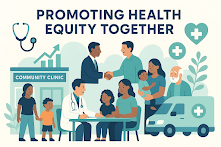How to Promote Health Equity: Role of Government and Community
How to Promote Health Equity: Role of Government and Community
Health is a fundamental human right. But in many parts of the world, people still face barriers to accessing quality healthcare based on their income, location, race, gender, or education. This imbalance is what we refer to as health inequity. Promoting health equity is about ensuring everyone has the opportunity to attain their highest level of health — regardless of social or economic barriers.
In this article, we explore the meaning of health equity, why it matters, and the crucial roles both government and communities play in creating a fair and just healthcare system for all.
🧠 What Is Health Equity?
Understanding the Concept
It does not mean that everyone receives the exact same treatment, but rather, they receive what they need to be healthy.
Health Equity vs. Health Equality
| Health Equality | Health Equity |
|---|---|
| Everyone gets the same resources | Resources are distributed based on individual needs |
| Focuses on fairness in quantity | Focuses on fairness in outcome |
| May ignore systemic disadvantages | Aims to remove structural barriers |
Examples of Health Inequities
-
Lack of healthcare facilities in rural areas
🏛️ Role of Government in Promoting Health Equity
H2: Why Government Involvement Is Essential
Governments are responsible for creating policies that protect public health and ensure fair access to healthcare services. They have the authority and resources to implement large-scale solutions to reduce disparities.
Key Responsibilities of Government
1. Policy Making & Legislation
Governments can pass laws and policies that:
-
Guarantee universal health coverage
-
Regulate drug prices and medical services
-
Enforce non-discrimination in healthcare
-
Support healthcare infrastructure in rural areas
👉 For example, the Indian government's Ayushman Bharat scheme aims to provide free treatment to over 500 million people.
Learn more from the official site
2. Public Health Programs
Effective public health programs target vulnerable populations and address major health issues like:
-
Malnutrition
-
Maternal and child health
-
Immunization
-
Hygiene and sanitation
✅ These programs ensure that everyone, especially the poorest and most marginalized, gets access to life-saving services.
3. Funding and Budget Allocation
Governments must prioritize health equity in their budget. This includes:
-
Increasing funds for primary healthcare
-
Investing in mental health services
-
Supporting indigenous and remote communities
4. Data Collection & Monitoring
Good policies require accurate data. Governments should invest in:
-
Nationwide health surveys
-
Health equity audits
-
Real-time tracking of diseases
📊 This data helps identify which groups are being left behind and allows for targeted interventions.
🤝 Role of Communities in Promoting Health Equity
H2: Community-Led Change Is Powerful
While governments create policies, communities bring those policies to life. Local people understand their needs better and can create grassroots movements to drive lasting change.
Ways Communities Can Promote Health Equity
1. Education and Awareness
Communities can:
-
Organize health education workshops
-
Promote preventive healthcare practices
-
Spread awareness about government schemes
🎯 Example: Local NGOs conducting free health camps and distributing sanitary pads in rural India.
2. Advocacy and Participation
Active community members can:
-
Attend town hall meetings
-
Speak up against injustice in local health services
-
Demand better healthcare infrastructure
📢 A well-informed community can hold authorities accountable and push for equitable change.
3. Support Networks
Communities can create:
-
Peer support groups for mental health
-
Local health volunteers or ASHA workers
-
Community-run nutrition centers
These efforts reduce dependency on external systems and empower people to help each other.
4. Collaborating With Local Health Services
Local partnerships between communities and clinics can:
-
Increase trust between doctors and patients
-
Improve vaccine acceptance
-
Enhance delivery of maternal care and child nutrition programs.
🌎 Case Studies: Health Equity in Action
Real-World Examples
Brazil’s Family Health Program
Brazil implemented a community-based primary care program that drastically improved health outcomes in underserved areas by deploying family doctors and nurses directly into neighborhoods.
India’s National Health Mission
This government program focuses on:
-
Strengthening rural health infrastructure
-
Training ASHA workers (Accredited Social Health Activists)
-
Targeting maternal and child health in remote regions
💡 It’s an example of community and government collaboration working toward equity.
Rwanda’s Health Equity Fund
Rwanda introduced a community-based health insurance scheme that has improved access for low-income households and reduced maternal mortality.
🧭 Challenges in Achieving Health Equity
H2: Major Barriers to Overcome
Despite progress, there are many hurdles:
-
Political will and corruption
-
Insufficient funding
-
Deep-rooted social inequality
-
Cultural beliefs and stigma
-
Misinformation and lack of education.
🚀 How We Can Move Forward
Action Steps for a Healthier Future
For Governments:
-
Pass and enforce pro-equity health laws
-
Allocate budget to underserved areas
-
Focus on preventive care, not just treatment
-
Collaborate with NGOs and private sector
For Communities:
-
Educate and engage the youth
-
Build trust in local health systems
-
Use digital tools for awareness
-
Participate in policy advocacy
🔗 Suggested Resource for Further Reading
Want to dive deeper into global efforts for health equity?
Check out: World Health Organization: Health Equity
Conclusion
Health equity is not a one-size-fits-all goal it requires tailored solutions, strong policies, and local engagement. Governments must create enabling environments, and communities must participate actively to drive real change.
If we work together, a world where everyone enjoys good health — regardless of their background is truly possible.





Comments
Post a Comment